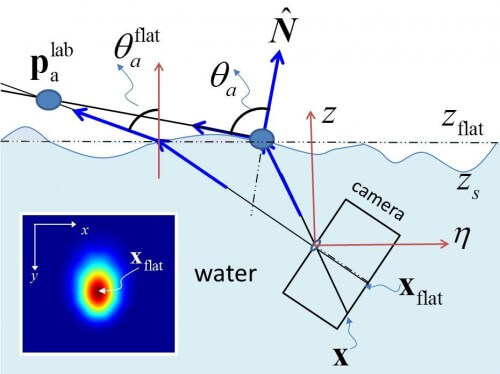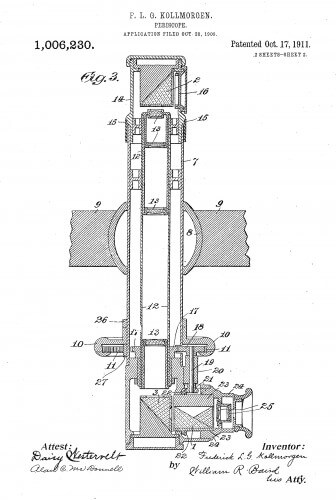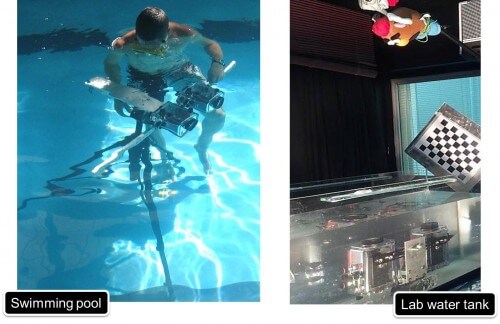We all know from the movies the tip of the periscope that peeks out of the water and reveals the location of the submarine • A "virtual periscope" developed at the Technion allows for the first time a completely underwater observation of what is happening above the surface of the sea * The periscope will be unveiled as part of the Scientists' Night at the Technion this coming Thursday

By Erin Biba, "Tested" reporter *
Over the years, certain changes have taken place in the physical structure and internal mechanics of the periscope, but one thing remains the same: to see what is happening above the surface of the sea, even the most advanced modern periscope must emerge from the water. And when the periscope is used as a weapon of war whose purpose is to evade enemy ships, it is clear that this prominence is not a smart move. This is why for more than ten years scientists and engineers have been trying to design a virtual periscope - a device that will be able to see what is happening outside the water without being forced to rise above sea level. A group of researchers at the Technion has now made impressive progress in this matter.
Periscopes: A Brief History
The first periscope, according to the information available to the US Navy, was designed in 1854 by a French chemist named Edme Ippolite Marie-Davy. It was simply a long cylinder, at each end of which a mirror was fixed at an angle of 45 degrees. In the decades that followed, several attempts were made to improve the device, and one of the versions was a cylinder inside which eight prisms were fixed.
The modern periscope, which we remember from the cinema, was an improved version of these models. The new version, patented in 1911 by Dr. Frederick Kollmorgen, replaced the series of lenses (or prisms) with a pair of telescopes. This structure completely eliminated the need for fixing lenses along the length of the cylinder and mirrors at its ends, and made it possible to build it in different lengths and to reduce the opening emerging from the water. Kollmorgan founded a company that developed and perfected the telescope, and this company - Kollmorgan - still operates today.
Kollmorgen's original design has undergone several improvements over the years - the addition of night vision, star pattern recognition, optical magnification and antennas for satellite communication - but the overall structure remains almost unchanged. It was only in the sixties that the US Navy developed the type 18 periscope, which was equipped with television cameras that transmitted the images all over the submarine and also recorded them.
About a decade ago, the US Navy replaced the periscopes in the "Virginia" attack submarines with photonic masts, which are telescopic arms at the top of which digital cameras and infrared cameras are installed. Since these devices have neither mirrors nor telescopes, there is no need to place control rooms under them. Therefore, the Navy moved the MIK (Combat Information Center) away from the sides of the submarine and lowered it to a lower deck, where there is much more space.

Periscopes in the future
Photonic masts have many advantages, the main one being the fact that they steer the submarine into the digital age. However, they also force the user to "peek" above the surface of the water, and therefore are not true stealth.
Yoav Shechner, a professor in the Faculty of Electrical Engineering at the Technion, is working on the development of a better periscope. He has devoted the last few years to dealing with the main problems related to the development of a virtual periscope that will be able to record from the water the activity above the sea level.
The main obstacle on the way to the construction of an underwater periscope is the refraction of light at the junction between water and air. This phenomenon is familiar to anyone who has ever dived into a pool and looked up, or put a spoon in a glass of water: when the light rays penetrate the water, they are refracted, and this means that the objects outside the water (or inside the water, like the spoon) look distorted. The more wavy the surface of the water, the more the light rays are bent in different directions, and as a result, the objects outside are distorted more.
To get a clear image from an underwater point of view we must correct the distortion created in the air-water medium. One of the ways to do this is to measure the waves and understand how the movement of the water at any given moment affects the resulting image. This challenge seems too complicated to be realized, but in astronomy such a correction has already been carried out for many years. "Viewing space through a ground-based telescope passes through the atmosphere," explains Shechner of the inspiration for his pioneering solution, "therefore the astronomers must measure the distortions caused by the atmosphere to the light rays and correct them. For this purpose, they use a guide star, i.e. a celestial object whose shape is known, or create such a virtual object by projecting a laser towards the upper atmosphere, and then measure the deformations that occur in it."
Unfortunately, in the middle of the sea there are not many objects that can serve as a guide star, except for one: the sun! Therefore, Schachner designed a photographic system that uses the sun (or the moon, at night) as a fixed reference point that allows the distortion in the images to be eliminated. This is how it works: half of the camera's field of view is covered by an array of holes - a piece of metal in which holes have been punched at a distance of 1.8 cm from each other. A semi-transparent light diffuser is installed below the array of holes, which allows the points of light emanating from the holes to land on a surface and thus reveal to the user in which direction they move when entering the water.
"If the water is not completely still, the rays break and distort differently in each hole, and the spacing between the projected points on the screen will be uneven because the waves create disturbances. The points do not settle in their expected position, and this unruly behavior is a very important source of information for us. By taking the screenshot and measuring the movement of the points, we can measure the distortion."
The other half of the camera's field of view is not covered, but simply pointed at the target (the sun or another object) and takes a blurry image. The reason why the camera is divided is that it is necessary to take both pictures at the same time in order to correctly "map" the distortion created by the water. The sun is a particularly effective static reference point in the event that the desired object is in motion. As soon as the image is taken it is analyzed by a dedicated algorithm that compares the two images, calculates the distortion and eliminates it.

Well, what do the images captured by this innovative periscope, 'Stella Maris' its name look like? "They are not perfect, but their quality is getting better and better," says Shechner. "So far we have achieved a significant reduction in distortion, even if we have not eliminated it completely. We are trying to do something that has not been done before. To the best of our knowledge, based on the professional literature, no one has ever introduced a virtual periscope. People talked about it, but we were able to present for the first time a basic and raw system that works successfully. As mentioned, these are the initial results."
Schachner and two of his students, Marina Alterman and Yochai Sabirsky, intend to develop a commercially applicable version of the system. In addition to improving the resolution of the images and their clarity, Schachner plans to reduce the size of the system (the current system is a large box). "We have another rabbit in the hat. The current system is very preliminary, large and clumsy, but good as a pilot. We need to know the angle of the sun relative to the system, and for that we use a crude compass and a basic level. It would be nice if we were able to introduce an electronic sensor into the system that would provide us with a more accurate orientation of the system. We also intend to improve the resolution by reducing the distance between the holes, although there is a certain limitation here: if the distance between the holes is too short, it is difficult to associate the points of light with the correct holes."
Although it is a basic system, Shechner says that he has already received inquiries from parties interested in implementing it. He says the final product may benefit not only submarines, but also divers seeking to know their orientation in the water. The new technology may also help scientists who study animals that cut the water frequently - for example whales and dolphins that leap out of the sea - in an attempt to understand how they move between the two mediums without interruption. The development of such a commercial product will, in any case, require a few more years.
* The article is based on an article published on the scientific website Tested on September 2, 2014

9 תגובות
Eyal
I responded to my father, not to you. I understand what you are saying about the waves and it seems right to me. I gave a different use to the idea - the approach of a diver to a sailing vessel. Here the angles are higher and I also think there is less of a problem with waves (due to the proximity to the yachts).
Nissim, read my first response, I think there is a very big difference between a periscope that is raised to a height of about 3 meters above the water and one that is limited to sea level, at a height of 3 meters the problem of hiding the waves that I talked about already almost completely disappears.
As for the fish, they hunt insects that are about 70°-90° above them, and this is also done in a quiet lake without waves... It's completely different when you have to watch a distant target on the horizon and 2 meter waves hide it from you...
my father
Your ideas seem good to me, but I don't think you're right that the idea has no use. A periscope is raised to a height of about 3 meters above the water, so the distance to the horizon will not change much if the periscope is underwater.
The idea can also be useful for a diver who wants to approach the ship without being exposed. From a distance he will be able to see what is on board a ship without being able to see him from the deck. There are fish already using the idea to hunt insects, so maybe God has a patent on it? (More correctly - he/she had a patent... more than 20 years have passed)
To the responder Abi, it's funny, but just yesterday I was thinking of a similar idea, to launch a mini-submarine at a distance of a few tens or hundreds of meters from the main submarine, and have it observe and transmit the video to the mother submarine... The problem is that such a facility would reveal the manned submarine, anyone who recognizes the observation facility The mobile (and it's even worse with an observation balloon which is very easy to spot) will immediately understand that there is an enemy submarine in the area that needs to be watched out for... the whole thing about submarines is to be secret, so that no one even knows you're there.
Such a product will have no use since a periscope also needs to be elevated in order to observe the direction of the horizon
It would be wiser to create a submarine drone or a balloon that could be launched under water to go up somewhere else and fly at a high altitude and send pictures
It is also possible to create a stealth periscope or a periscope that looks like waste or a transparent periscope from prisms and glass
http://www.tested.com/science/464266-inventing-modern-periscope/
Another problem that, in my opinion, will make it difficult to realize the idea is that the sea water, apart from the distortion it creates, also absorbs a significant percentage of the light that passes through it, a strong and clear light source like the sun will probably be able to be seen, but I doubt about weak light sources such as distant targets, even so the amount of light that comes from them is weak , and another part of it will be swallowed by water... the amount of light that will eventually reach the viewing facility in the submarine will be very weak.
Avi, FYI the link at the end of the article does not work.
On the face of it, the idea sounds very interesting, but it seems to me that there is one major problem here that can also be noticed in the first photo attached here, the sea waves greatly limit the angle of vision... even if a perfectly sharp picture is obtained, the sea waves (which usually have an average height of between one and a half meters) to two meters in the depth of the sea) will make it possible to distinguish only very close targets, the waves that are close to the observation point will simply hide the image coming from targets on the horizon.
Perhaps a better solution would be to simply transmit images from a satellite above the area to the submarine...